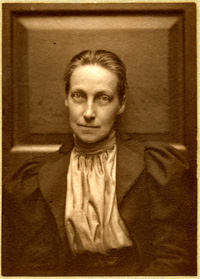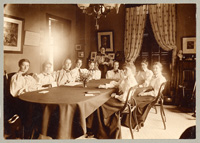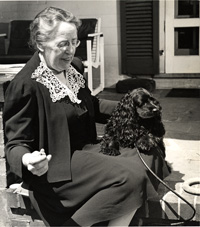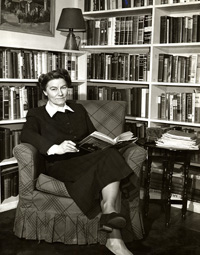The History of History at Vassar College
by Leslie Offutt, Associate Professor of History, Department Chair - May 2010
January 2011
Department Website
"Doing history at Vassar means building a personal working relationship between student and teacher. It means talking about history and writing history based on the collection of more than half a million volumes in our library. It means working with faculty members who believe, above all, that history is fun. At Vassar you will find a dozen very different historians united in one thing—the evident pleasure we take in the exercise of our craft."1
The words above, written more than a quarter-century ago, could as easily have been written in 2010 as in 1983; indeed, they could have been written no less easily in 1887, when Lucy Maynard Salmon, Vassar's first history professor, founded the History Department. In its first quarter century, Vassar College taught only a handful of history courses in any given year and, lacking a historian on the faculty, those courses were taught by other faculty, and occasionally the College president. Salmon's arrival affirmed the College's new commitment to the serious study of history under the guidance of specialists in that field. Moreover, Salmon's rejection of traditional methods of teaching history—through memorization and recitation of facts about prominent people and events—and her embrace of new approaches whose use permitted a deeper understanding of the past set standards that the department continues to honor today. An early practitioner of the "new social history," Salmon encouraged her students to "go to the sources," to weigh evidence, think critically, question conventional narratives, and formulate their own arguments. And she encouraged her students to move beyond the traditional sources—laws, charters, and the like—to more mundane materials such as train timetables, shopping lists, even the Vassar Catalogue. Students came to appreciate "history in a backyard" (the title of a 1915 piece, available in Vassar College's Special Collections), as well as the royal courts of Europe and the founding of the American Republic.
The early twentieth century
The first decades of the new century were years of impressive growth for the Department. As early as 1908-09, courses were offered in American History, English Political History, The French Revolution, Contemporary History, Ancient History, the Literature of American History, The History of Northern Europe, Modern Russia, The Historical Geography of North America, Nineteenth-Century History, The Renaissance, The Reformation, Prehistoric Europe, The Development of Municipal Government, History of British Colonization, The Modern British Constitution, The History of the Civil Service in the United States, and The Nature and Treatment of Historical Material. In 1912 the Department added a course on The Far East, and in 1914 one on The Near East. In 1917, as the United States prepared to enter the European War, the Department offered a "series of informal lectures on the general subject of the antiquity of the questions at issue in the present war and the relation between past and present conditions," with department faculty treating such topics as "The Freedom of the Seas" (Ida Carleton Thallon), "What is Modern History?" (Lucy Maynard Salmon), "Neutral or Ally?" (C. Mildred Thompson), "Old and New Boundary Disputes" (Eloise Ellery), "Macedonia—the Apple of Discord" (Lucy E. Textor), and "Poland" (James Fosdick Baldwin). 2
The 1920s
By the time Salmon retired in 1927 Vassar's History Department had grown into one of the College's most prominent and active. Aside from a few male faculty, notably James F. Baldwin (1897-1941), who focused on medieval and modern Europe, female faculty predominated in the Department; talented women who followed the protocols of the newly professionalized discipline and obtained Ph.D.s nonetheless found themselves largely barred from careers at men's or co-educational colleges and universities. Women's colleges, therefore, provided a professional home. Of the faculty who taught at Vassar for extended periods before World War II, seven had received their B.A.s at Vassar, studying with professors like Salmon and Eloise Ellery (a member of the Vassar class of 1897), who from 1900 to 1939 taught the Renaissance and Reformation. Another alumna who returned to teach was C. Mildred Thompson, a 1903 graduate who taught modern United States history from 1910 to 1923, when she became Vassar's Dean of the College. Holding that position until 1947, she is remembered as a formidable campus presence.
The 1930s
The next generation of historians, arriving in the 1930s, included Mildred Campbell, who taught England and Modern Europe, and alumna J. B. Ross. Charles C. Griffin, a noted historian of Latin America and U. S. foreign relations, arrived in 1934 and remained at Vassar until 1967; the Department today hosts an annual lecture in his name, as well as ongoing lectures from a fund in honor of C. Mildred Thompson.
Evalyn A. Clark '24 and Mildred Campbell
Five years after Charles Griffin's arrival, Vassar hired Evalyn A. Clark, a member of the Vassar Class of 1924, a dynamic teacher who captivated generations of students. A historian of modern Europe, Clark was famous for teaching with the New York Times in one hand; during and after World War II, she would begin her courses with contemporary events and then work backward to locate their roots and causes. In honor of Clark, former students have established the Evalyn Clark Memorial Travel Fellowship. Each year, these grants provide Vassar History majors with an opportunity to expand their study of history through travel for the purposes of research or of experiencing the culture in a region of historical interest. Both Clark and her colleague Mildred Campbell were, like their predecessor Lucy Maynard Salmon, pioneers. Both were early advocates of the study of women and gender; Clark was a founding member of the Berkshires Conference of Women Historians, and both Clark and Campbell served as presidents of the Conference.
Swift Hall
Swift Hall, a stately Georgian colonial revival building built in 1900, originally served as the College's infirmary; one can still see traces of that incarnation in the dumbwaiter that transported meals to the upper floors, the "bell boxes" on the landings, and the lovely porches that served to allow convalescing students to enjoy the fresh air. As the College prepared in 1940 to relocate the infirmary to the newly-constructed Baldwin House, the History Department appealed to President MacCracken to be allowed to relocate to Swift. The Department offered a compelling argument—its faculty were housed in two different academic buildings (Rockefeller Hall and Avery Hall) and taught in three, and four of the Department's ten faculty members lacked offices. The College approved the move, and the Department took up residence in Swift Hall in 1941, where it remains today. It has been a most happy home, and today both History majors and faculty alike use the terms "Swift" and "History" interchangeably when referring to the Department, a sign of how the one stands for the other in our minds.
The Post-War Era
The post-war era brought a wave of new talent, including Vassar's first historian of science Rhoda Rappaport, who joined the History Department in 1961. In contrast to previous generations, most new faculty after 1950 were men: the noted United States historian Carl Degler; Hsi-Huey Liang, who taught German and Russian history; English Historian Donald J. Olsen; Jonathan Clark, a colonial and Revolutionary American historian; Donald Gillen, an East Asian historian; Benjamin G. Kohl, a scholar of the Renaissance. Professors hired during those years and who remain today, as emeritus faculty, active scholars include United States historian Clyde C. Griffen, historian of Africa and African-American history Norman Hodges, David Schalk, a scholar of French history, and historian of Victorian England Anthony S. Wohl.
In the tradition of C. Mildred Thompson, historians have continued to play important roles in College governance. Vassar President Alan Simpson, who oversaw the transition from single-sex to coeducation between 1964 and 1977, was a scholar of Puritanism with a D.Phil. in History from Oxford. Nancy Schrom Dye, a historian of women, served as Dean of the Faculty from 1988 to 1944, and went on toe become President of Oberlin College. George D. Langdon, Jr., who taught American history from 1964-69, served as President of Colgate University from 1978 to 1988.
Recent years
In recent years the Department has hired an increasingly diverse faculty and has developed a fully global curriculum, with offerings not only in Europe, the United States, Latin America, and Africa, but also East Asia, Central Asia, South Asia, and the Middle East. The Department continues its tradition of requiring a senior History thesis, which each major completes in consultation with an adviser. Because Lucy Maynard Salmon's successors have continued, over the years, to insist that students do extensive research in primary sources, the Vassar College Library houses an exceptionally rich treasure trove of historical materials for students to use in their coursework and senior projects.
In a February 1938 radio address, Louise Fargo Brown, a department colleague whose tenure overlapped with Salmon's, beautifully captured the significance of Salmon's role in shaping the teaching of History at Vassar:
Those of us who were in the department in Miss Salmon's day, when we go to professional meetings, smile to ourselves as we hear talk of the "new trends" in history. To us they are not new. They were new in the days when Miss Salmon was sending her students to attics to find old forgotten things; when she was teaching them to find history in place names and playing cards, in back yards and on Main Street. We realize on these occasions that when the time comes for us to retire from active service our successors will be young persons trained in the newest of the new history, who are prepared to carry on the traditions of the department and present history as a living force, ever-changing and ever demanding to be rewritten.3
Brown speaks to values that we continue to hold to in our teaching. We continue to believe in a useable past, one that strengthens our grasp of the dreams and struggles of our own world. We aim to help students develop their capacities for independent research, critical analysis, and imaginative synthesis. We vary widely in our teaching approaches; what we share are the convictions that research, teaching, and learning are inextricably linked, and that teachers and students cooperate in the experience of historical inquiry. History majors not only receive a superb education; they leave Vassar carrying intellectual passports that help them explore a lifetime of new realms.
References
- 1. "Department of History, 1983/84," "V.C. Departments and Programs: History," Subject File 10.61-10.62, Archive and Special Collections, Vassar College Library.
- 2. "Vassar College Department of History, 1917," "V.C. Departments and Programs: History," Subject File 10.61-10.62, Archive and Special Collections, Vassar College Library.
- 3. Vassar College Special Collections, Vassariana, Subject File 10.62, Radio Address (WNYC), February 8, 1938, Louise Fargo Brown.




